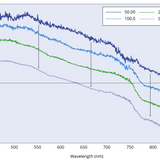Sources of Error in UV-Vis Spectroscopy

UV-Vis spectroscopy is a powerful analytical tool used in many fields to investigate and observe changes in material properties. However, like any analytical technique, all spectrometers - including the Ossila USB Spectrometer - are subject to error under certain conditions.
You can reduce or remove some of this error by changing your sample preparation or experimental procedures. However, there are some instrumental limitations which can play a role in taking optical measurements. For systematic errors, you need to examine the spectrometer components more closely.
Dark Noise
In a spectrometer, when photons land on a pixel of the detector, electron-hole pairs are created, with their number proportional to the number of incident photons. This charge is converted into a voltage and then a digital signal, which is displayed as a spectrum.
However, electron-hole pairs can also be generated by thermal effects. These "dark" electron-hole pairs are indistinguishable from those generated by photons and so will affect the resultant spectrum. These unwanted signals are therefore known as "dark noise".
Dark noise is dependent on the integration time used and can be reduced by cooling the detector. The dark noise of the Ossila USB Spectrometer is < 50 counts at 50 ms integration time.
Stray Light
Stray light is a measure of the light collected by the detector that is of a different wavelength to the expected value for that pixel. This occurs because pixels can only measure the intensity of the incident light and cannot distinguish wavelength. Sources of stray light include (but are not limited to) unwanted reflections or scattering from lenses, imperfect mirrors or optical components; leakage into the spectrometer from its surroundings; and re-entrant spectra. This can indicate that your cuvette is damaged or incorrect or that seals are damaged in your spectrometer allowing in extra light.
Re-entrant spectra arise from light that is diffracted by the grating more than once. For example, light that has already been diffracted can be reflected by optical components, such as the detector or the entrance slit, back onto the diffraction grating, where it is diffracted a second time. If this light reaches the detector, it will produce an unwanted signal.
Stray light can also arise from imperfections in the diffraction grating. This can be minimized by using holographic gratings, which are fabricated using optical techniques and have a sinusoidal profile, rather than blazed gratings, which are fabricated using mechanical techniques.
The Ossila USB Spectrometer has a stray light percentage of < 0.2%.
Spectral Bandwidth
The spectral bandwidth of a spectrometer is determined by the band width of the spectroscopy light source you are using and the resolution of the spectrometer itself. By resolution, we essentially mean how close two peaks can be (in terms of wavelength) and both still be resolved as individual peaks. This is measured using a monochromatic light source that will produce a very thin peak. You then measure the full-width half-maximum of this peak, and the broadness of this line will represent the spectral resolution of a spectrometer.
An Ossila USB Spectrometer has a resolution of 2.5 nm. This should be perfect for most optical measurements. However, this resolution may not be sharp enough in specific circumstances. For example, if you need to measure sharp peaks with extreme precisions or if you are distinguishing peaks that are less than 2.5 nm apart. For either of these measurements, you may need a specialized high-resolution spectrometer.
USB Spectrometer

Learn More
 Negative Absorbance: Can Absorbance Ever Be Negative?
Negative Absorbance: Can Absorbance Ever Be Negative?
In general, you should not be measuring negative absorbance values for any sample.
Read more... UV-Vis Spectroscopy Troubleshooting
UV-Vis Spectroscopy Troubleshooting
UV-Vis spectroscopy (or optical spectroscopy) is a simple, versatile and critical tool for sample characterization. It is the most common type of spectroscopy, and a powerful method for analyzing material properties, allowing scientists to study a material's molecular properties, structure, and behavior. UV-Vis spectroscopy can also be used to monitor reactions, identify materials for certain purposes and to investigate the molecular structure.
Read more...Contributing Authors
Reviewed by
Product Specialist
Application Scientist